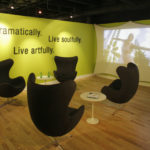A properly designed sales center is one of the most important touchpoints in the homebuying journey, consistently working to ensure long-term value and sales growth. This is the core of the sales experience, front window of your brand and the first opportunity to inspire your visitors, create real emotional engagement, and help them envision what it will be like to live in your community.
Why does this matter? Because an emotionally engaged visitor is significantly more likely to become a buyer and also more likely to be willing to spend more for their home. Which means a shorter path to the sale, happier buyers and salespeople, and a higher ROI.
So what makes a great sales center? We believe it comes down to two things: Compelling content and thoughtful design. Here are some tips for creating a thoughtfully-designed sales center that engages and inspires.

Experience wall at Babcock Ranch’s Discovery Center
• Represent Your Brand – Your sales center should reflect your brand’s positioning, promise and personality. It should look like your brand, feel like your brand, and clearly convey what makes your brand distinctive throughout the visitor experience.
• Tell a Story – To be effective, your sales center must tell a compelling story that can be clearly understood by visitors regardless of whether they are accompanied by a sales representative or not. This requires defining the specific information needed to tell that story as well as how to best present it sequentially and creatively.

Bringing brand elements to Storey Communities’ Sales Center
• Optimize Your Space – Ideally, the space you allocate to your sales center should be in proportion to the size and scale of the community it represents. Large master planned communities require large spaces to tell their stories, while smaller communities or specific homes can utilize smaller spaces or their models. The space itself must be able to accommodate visitor traffic, your sales representatives’ work areas and an area for environmental graphics and other visual elements or experience areas to tell the story.

A well-branded sales center at C
• Create a Comfortable Environment – You want your visitors to feel welcome and comfortable during their visit so they’ll relax. You can accomplish this by creating an environment that looks and feels more like a delightful area than a salesroom. Warm tones, the right furnishings and hospitality go a long way. Just be careful not to make it too relaxing – you want visitors to keep moving through the sales center and prepared to take the next step in the purchasing journey.

Wall graphics direct a brand story through a critical path
• Establish a Critical Path – To better help orient visitors on how to move through the sales center, a critical path is built with an intentional formula for content and how it should be acknowledged in conjunction with a sales pitch. The visuals of this path support and strengthen the sales presentation and align with the brand and community story.
• Go Macro to Micro – Your sales center critical path and story should follow a macro to micro approach so that visitors are presented with the broadest and most universally relevant information first before being presented with more specific details. A great place to start is by using maps as a starting point to orient visitors on where they are, what’s around the community, and the site plan itself before proceeding with other story elements.

A timeline presenting the progress of Babcock Ranch in their Discovery Center
• Deploy a Variety of Media – Because visitors have taken the time to travel to your community to experience it firsthand, the last thing they want to do is spend their entire time in the sales center interacting with a computer monitor. While monitors certainly have their place and can be tremendously helpful, it is important to engage all senses and make full use of your space using a variety of media, including wall graphics, panels, experiential displays, video, and topographic maps. The more varied and interesting the media, the more engaging the experience.

Unique seating in the lobby at Venu’s Sales center
• Make It Unique & Memorable – Another factor critical towards creating emotional engagement is to make the experience feel unique and memorable. This can be accomplished through design elements and imagery, and how information is presented visually, but most critical is how the sales representatives engage with and present to visitors. Effectively training your sales team to know how to gather information, customize their presentations and demonstrate excitement and enthusiasm along the way is a critical success factor.

Lifestyle focused branded entry at Patrick Square
• Sell the Lifestyle Before the Product – Finally, while many sales representatives are inclined to want to go straight to communicating information about homes, it is important to make sure the sales center sells the community lifestyle before the product. Home buying trends point to consumers considering their lifestyle as a top priority in their home buying decision, and the sales center represents the best opportunity to effectively communicate the people, amenities, activities and programming that will create that lifestyle. Make sure your critical path reflects a lifestyle focus and that your salespeople are trained to focus on presenting lifestyle first.
Walker Brands excels at “connecting people to places” and creating thoughtfully designed sales centers that create emotional engagement and increase sales. To find out how we can help you get the most out of your sales center investment, call us today at 813-875-3322.

